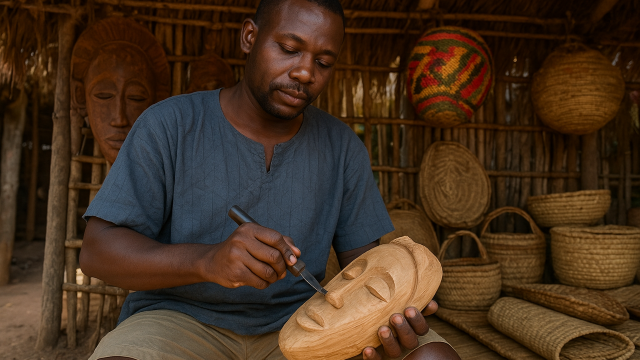In workshops shaded by corrugated roofs and in open-air markets where the sound of haggling mixes with the scent of wood shavings, Gabon’s artisans carry forward traditions rooted in centuries of practice. Their craft is both livelihood and legacy, a testament to resilience in the face of industrial production and shifting cultural currents.
Wood carving remains among the most emblematic of Gabonese handcrafts. Masks carved from dense local hardwoods, such as ekang masks, embody stories of ancestry, ritual, and social identity. Each curve and incision reflects both individual artistry and collective memory, symbols of continuity that bridge generations. Beyond masks, artisans fashion stools, statues, and ceremonial objects, all serving as cultural markers while sustaining economic survival.
Weaving, too, endures as a vital expression of creativity. Baskets, mats, and textiles are made from reeds and fibers gathered in nearby forests, their patterns often echoing the natural landscapes from which the materials are drawn. The interplay of form and function—whether a basket designed for daily use or one created for ceremonial exchange—underscores the intimate connection between craft and environment.
The country’s artisans also face a set of modern dilemmas. Mass-produced imports, often cheaper and more accessible, threaten the survival of traditional handcrafts. Younger generations may view artisanal work as less viable compared with other professions, further straining the continuity of these practices. Yet, efforts to support the sector are visible. Festivals celebrating local talent, organized both by community groups and with governmental backing, provide platforms for artisans to display their work. Demonstrations at these events allow techniques—such as basket weaving or pottery—to be shared openly, reinforcing the cultural value of practices at risk of fading.
Some workshops now invite participants to learn directly from the makers. Visitors sit alongside artisans, practicing weaving or carving techniques under the guidance of masters who pass on both skills and the stories embedded in them. These exchanges reinforce the cultural dimension of handcrafts, reminding participants that the objects carry meaning beyond their material form.
For artisans, each piece represents more than craft. It is an assertion of cultural identity and continuity in the face of globalization. A hand-carved mask or finely woven basket embodies not only aesthetic appeal but also the narratives of community, spirituality, and environment.
Gabon’s handcraft traditions endure because they adapt, balancing preservation with innovation. In their persistence lies not just economic sustenance but the preservation of a nation’s cultural fabric—quietly reaffirmed with each stroke of the chisel, each thread woven through reed or fiber.
Sources
- Fernandez, James W. Bwiti: An Ethnography of the Religious Imagination in Africa. Princeton University Press, 1982.
- Perrois, Louis. Arts du Gabon. Orstom Éditions, 1985.
- UNESCO Intangible Cultural Heritage. “Mask-Making Traditions of Central Africa.” Accessed 2025.
- International Trade Centre. “Creative Industries in Central Africa: Handcrafts and Cultural Heritage.” Accessed 2025.


